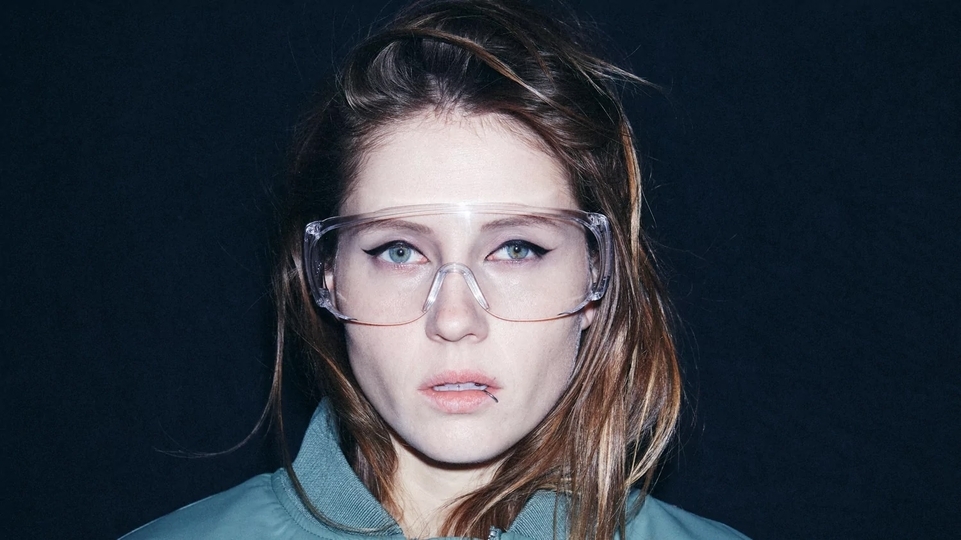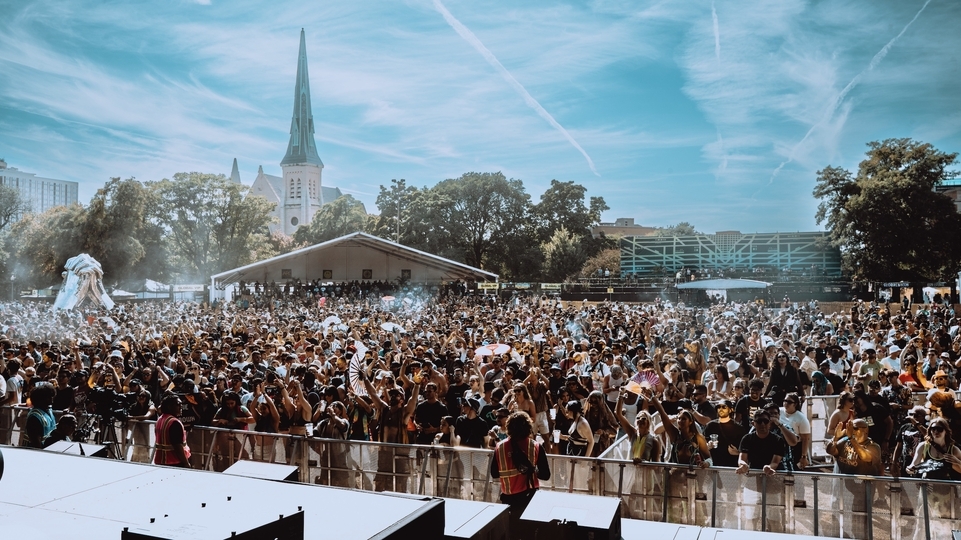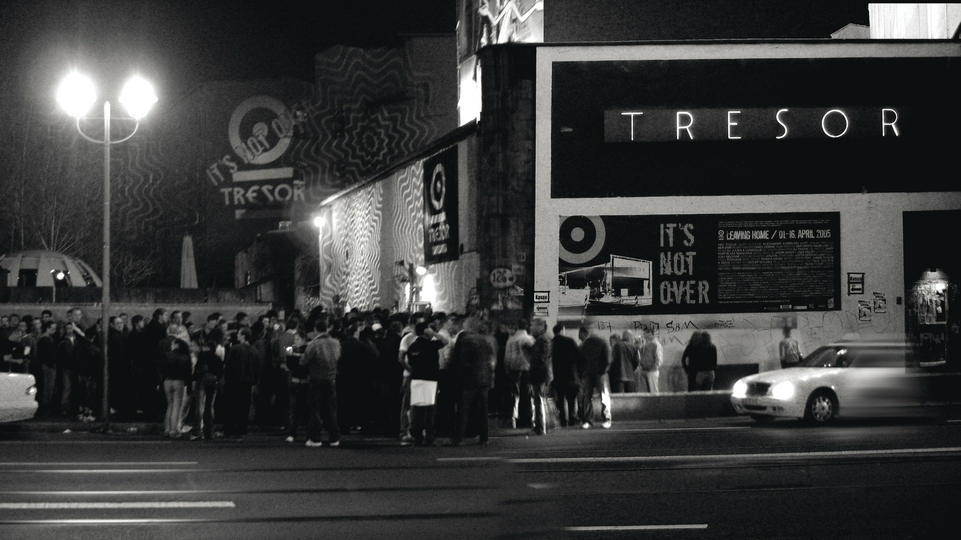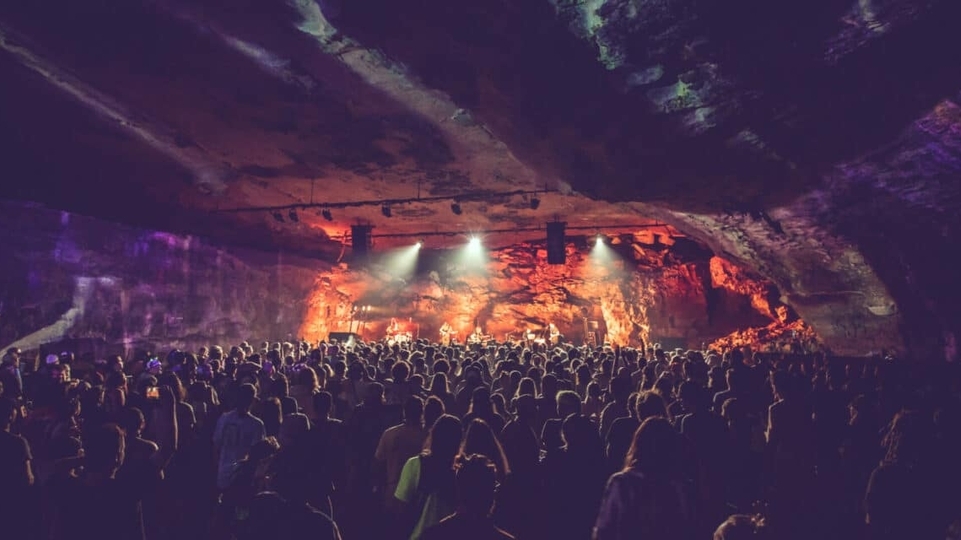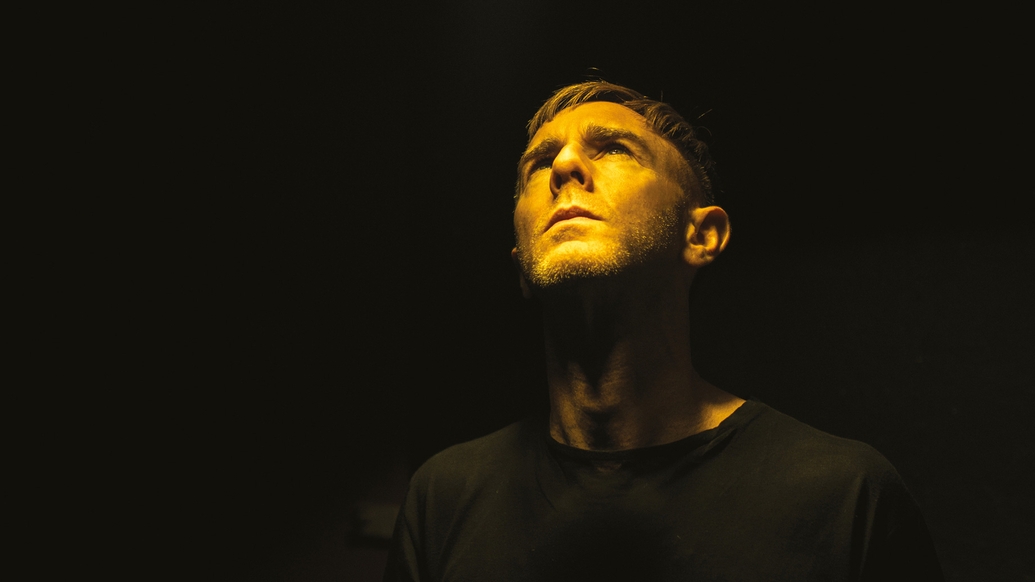
Richie Hawtin: Techno’s future-focused pioneer
Richie Hawtin is one of the most pioneering artists in electronic music, and a true proponent of techno’s future-focused ideology. As the winner of DJ Mag’s Best of North America Outstanding Contribution Award 2019, the Canadian has maintained a position at the top of the game for over two decades. DJ Mag caught up with Hawtin at his F.U.S.E. exhibition in London to reflect on the growth of techno, the hard times, and how his philosophy of balance has kept him afloat in an ever-changing world...
The low spring sun is struggling to make a difference as the staggered city peaks of Central London interrupt its pale light. We’re at 180 The Strand, a Brutalist art space currently dressed from head to toe in scaffolding as a major refurb project is underway. DJ Mag finds a spot in the corner of a café somewhere around its winding corridors, where intermittent drilling and unidentified clanging echo into a contrasting blissful silence, before jarringly cutting through the calm once again.
It’s a more than suitable place to speak to Richie Hawtin, whose myriad of aliases, tours, releases, labels and projects has seen his career protrude and retract, bringing with it its fair share of noise and, more recently, an appreciation for silence. His career has seen him conquer electronic music many times over, taking his Detroit-influenced sound to the biggest festivals, clubs and events on the planet over the past quarter of a century. As Richie joins us in the lazy sunlight, he’s smiling, upbeat and positive, despite not having had any breakfast. Do you get hangry? we wonder aloud, with an image of the techno legend grumpily stomping around his kitchen dressed head to toe in his trademark black bringing a smile to both our faces. “No but my wife gets that really bad! It takes a lot for me.”
We’re in Central London for a reason: his new exhibition with his brother and visual artist Matthew Hawtin opens tonight. It celebrates the re-release of his F.U.S.E. albums — including one unreleased LP — one of his many aliases from his early career. The artwork is on display alongside a looping soundtrack of the record played through The Vinyl Factory Sound System, which sounds as good as its name suggests. The art forms complement each other remarkably well, and it’s no coincidence.
“We were both going through similar things at that point in our lives, looking into ourselves, trying to find who we were as artists, trying to find my sound, Matthew trying to find his visual identity,” says Hawtin, whose relationship between his work and his family has always been a close one. Working in robotics, his father Mick was instrumental in igniting a young Hawtin’s imagination around electronics and technology. Much later, Mick even built Richie a custom 10-channel version of his own MODEL 1 mixer as a Christmas gift.
“Then Matthew went away to college, he’d be painting, sending me photos, I’d be sending him tapes of early F.U.S.E. records or a Plus 8 release, so there was always this sharing of ideas. If anyone opened my eyes to the visual concept of minimalism, it was my brother. That time was very important to my artistic development.”
Hawtin often pauses as he speaks, considering every phrase and sentence carefully and calmly. You can almost sense his mind whirring as he drops each word in its rightful place, often delivering sound bite-worthy sentences in the process. As is often the case with something as retrospective as a re-release, we start to reflect on his early career and the road he’s traveled since. “Music was around the world [back then], but it wasn’t the powerhouse or the industry that techno has become. I think it’s important for the whole scene — and for myself — to look back right now to remember the purity of that time, and to remember the intention was to make futuristic music to go beyond what we were capable of as individuals, to go beyond our little social circles and to dream bigger.”


“We all dreamed and hoped that we could continue making music for our lifetime and that techno wasn’t just a disco fad or something — we’ve proven that it has staying power, but can it continue to evolve?”
Nostalgia
Another reason we’re feeling nostalgic is that Richie has just received the Outstanding Contribution gong at the DJ Mag Best of North America awards. The award, given to figures in electronic music who’ve positively shaped the landscape over their career, has Hawtin reflecting once more — something he’s not too comfortable with. After all, isn’t nostalgia the enemy of techno?
“It is and that’s why I try not to look back too often, and having an award like that, there’s a weight to it, so you have to stop and reflect and think,” he says. “It is, on one hand, the enemy of techno and the ethos of where this music came from, [but] it also celebrates how strong that ethos has been and how it’s created a whole foundation and tapestry of music that continues to evolve today. We all dreamed and hoped that we could continue making music for our lifetime and that techno wasn’t just a disco fad or something — we’ve proven that it has staying power, but can it continue to evolve?”
With over two decades nestled firmly at the heart of the genre, Hawtin’s in a better place than most to comment on the new batch of techno releases and artists that are fronting the genre’s current global wave. “I can hear records coming out now and I hit my forehead and think ‘I can’t believe someone’s made a record like this.’ It sounds exactly like a record that came out 20 or 30 years ago and people are going crazy for it. And y’know, it works because it worked before. I can’t put myself in the shoes of this generation, hearing any kind of techno record for the first time, because I’ve heard them for 25 years. So, I’ve got to find new ways to excite and inspire myself with new forms, but I [also] wanna be open to letting everybody appreciate everything that’s come before as something new and fresh.”
That freshness he seeks isn’t just what’s inspiring him, but inspiring a new generation of audiences that have migrated to his recent shows, as techno’s global ascension continues to attract EDM converts. “I was at Ultra [Miami] recently and you can look at it in different ways,” he begins. “Sure, it’s a huge EDM festival, but it’s also a festival that’s expanded from one Resistance [the Ultra-owned, techno-heavy, underground-leaning event series] tent to I think three, and is opening up the gateway further to kids discovering our style of music.
“During my set I could really feel like some kids out there, it was their first time hearing our music. They were responding in a way that they might to a more commercial EDM act, responding to big drops, but they were just starting to get sucked deeper into our culture. It was funny at times, but it was overwhelmingly positive and incredible — this is another generation, they are getting floored by the kind of music we’re playing, they’ve never heard this style. This is exactly what was happening to us back then.”
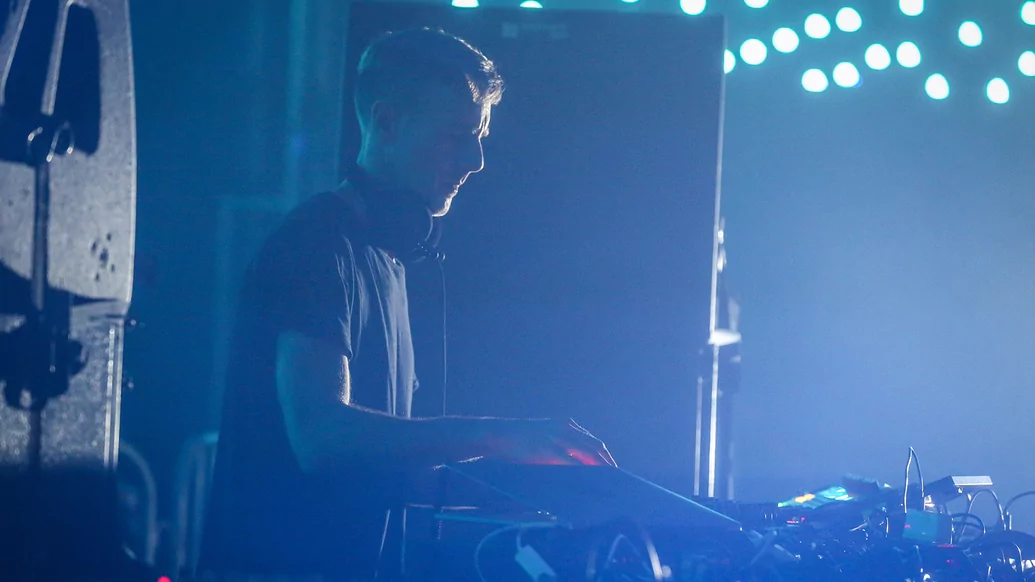

Underground
One of the common threads among more underground — albeit less reactionary — producers and DJs during the EDM explosion, was that it would eventually lead to a stronger underground. As those who were initially intrigued by the sonics of EDM, matured and developed their tastes, they’d eventually seek something more esoteric as they discovered their niche. It’s a mantra Hawtin firmly believes in. “So much has happened over the past five or ten years, we’re all looking around thinking ‘Wow, how did techno become so big?’ And it is part of that EDM explosion, it is part of bringing and welcoming more people than ever before into our wider electronic music community. The people that walk through that door are looking for a lot of different things and some of them find this little techno corner, some by accident, some by constant searching over months or years.”
As the current genre-du-jour, techno is definitely seeing something of a resurgence, but is its ethos being eroded in the process? “We’re not the small, underground, unknown, faceless community we were 25 years ago, but in comparison to the scope and size of electronic music, we’re still the weirdos in the corner. I wanna celebrate us weirdos in the corner with other weirdos who allow us to play cool records, and twist people’s heads off and still feel like we’re taking techno into the future.”
Ultra did bring with it the powerhouse that is Resistance, but only a few days prior to our chat — still soundtracked by intermittent drilling — KFC had purchased a DJ slot at the Miami festival, where a swollen-headed Colonel Sanders serenaded the bemused crowd with a haunting refrain of “I’m Colonel Sanders! I am everywhere!” Recently too, Red Bull Music Academy and Red Bull Radio announced they’d no longer be operating, at least in their current form. Two very different examples, but similar at their core — brand-sponsored electronic music-related projects. Given Hawtin’s underground credentials, we wonder what he believes the continued role of brands in music will be — positive and negative — and if the EDM bubble brought with it new and engaged techno fans, did it too bring with it the commercialism that drew so much ire in the first place?
“In the early ’90s, when electronic music started to get its first surge of popularity, major labels came in and signed some underground acts, other underground artists were doing mixes for Madonna. Sometimes people would ask ‘Are they selling out?’, but I always thought ‘Stay the course, have as many like-minded people around you, stay independent, grow.’ What I’m trying to say, I don’t think there’s anything different now than there was 20 years ago. There were always people poking into our scene with money and ideas, promising things, telling people they’re going to make them a star. Some people went that way, others didn’t. There’s enough of us that stayed as connected as possible to where we came from, grew with the scene, and stayed true to our values.”
He’s sat forward now, clearly a topic he’s considered before. “Everything’s more visible. Information flow, social media — back in the day, Plus 8 was offered to be bought by one of the majors. John [Acquaviva, Hawtin’s label co-owner] and I were having meetings, they were gonna take the label, take the artists. Of course, we didn’t do it, but that was all happening it just wasn’t so much on everybody’s radar.
“The explosion of EDM was crazy. It sucked some of us up, it sucked me up a little bit, just by how big it got. We did Plastikman Live at EDC — of course there were a lot of people scratching their heads, but there was also a lot of people saying, ‘What is this crazy music?’. Beatport got bought by a major investor, and so did a lot of other festivals. There will always be people coming in and trying to take advantage of things that they don’t understand.”
It’s refreshing to hear from an artist who’s evolved far beyond the underground, into the active consciousness of electronic music fans everywhere. Hawtin’s success means he’s by no means obliged to champion underground philosophies, but feels now they’re more important than ever. “It’s up to us as individuals and the scene as a whole, to have strong armor and deflect the people who are here for the wrong reasons, and stay connected to our brothers and sisters in the scene who are committed to this as a life-long experience and adventure.”

"You have this repertoire that you can dig into: records, frequencies and loops, listening and navigating in the moment, you’re on the trip as much as anybody else. That moment is the epitome of techno”
CLOSE Encounters
One of that adventure’s most recent offspring is his CLOSE show, a 75-minute audio-visual experience that combines DJing with live performance, introducing a spontaneity that DJing alone simply couldn’t offer. Using infrared cameras, Hawtin’s movements are traced and projected on giant screens, giving the audience an abstract glimpse into his art as he darts from one piece of kit to the next, his blurred, smeared limbs leaving ghostly projections behind.
“I’m always listening and giving and receiving as much energy from the people around me as possible,” he explains. “That’s what I love about performance, that’s what the art of DJing is, more than any other art form in my mind. When you’re really doing it well, when you’re really locked into the moment, you’re listening and responding, there’s a level of sensitivity in a great DJ set that is unparalleled.
"You have this repertoire that you can dig into: records, frequencies and loops, listening and navigating in the moment, you’re on the trip as much as anybody else. That moment is the epitome of techno. Searching and discovery, mystery and adventure at the moment of creation. That’s probably also why I do more performance than studio work — of course, performance takes me away from studio work — but the experimentation I can do live and what I’m doing with techno and CLOSE, that’s why I got into electronic music. Me, machines, people around, technology and frequencies, it’s like a little explosion you’re in the middle of.”
Two years after he debuted the CLOSE concept at Coachella, it’s time to reflect once again, this time on the show’s influence and evolution. With rave reviews (pun intended), CLOSE’s transition from Hawtin’s mind to ours has been a success, but it wasn’t a simple path. “I know there’s a certain amount of people in techno, or underground, or whatever you want to call it, that don’t feel that this music fits at festivals on the main stage,” he says. “It’s a very fine balance, transferring this music from a club, an immersive experience, onto a large stage and still keeping the essence of the music. I’ve been experimenting with that for 10 or 12 years, and CLOSE is as close as I can get to creating a live techno show that can compete on that level — in front of thousands of people, next to a rock band or whatever.”
Transitioning to the main stage can often be associated with theatrics, something Hawtin was keen to avoid. “Why it works, I think, is that there actually is no ‘show.’ All it is, is cameras going through computers and augmenting what’s happening in real time. I don’t have to worry about what’s happening behind me, there’s no real discussion about what I have to play or hitting certain timelines, I start and I go on my journey, and my cameras capture what’s happening, and we twist it just enough through visualization technology to turn it into this entertaining spectacle.
“It’s like being with me in the studio, not caring if anyone is looking in, and doing something that’s turning me on, and I’m thinking ‘This is fucking cool,’ I could easily be by myself in my parent’s studio, in the same way as I’m on stage at Glastonbury or whatever, in front of 10,000 people.”
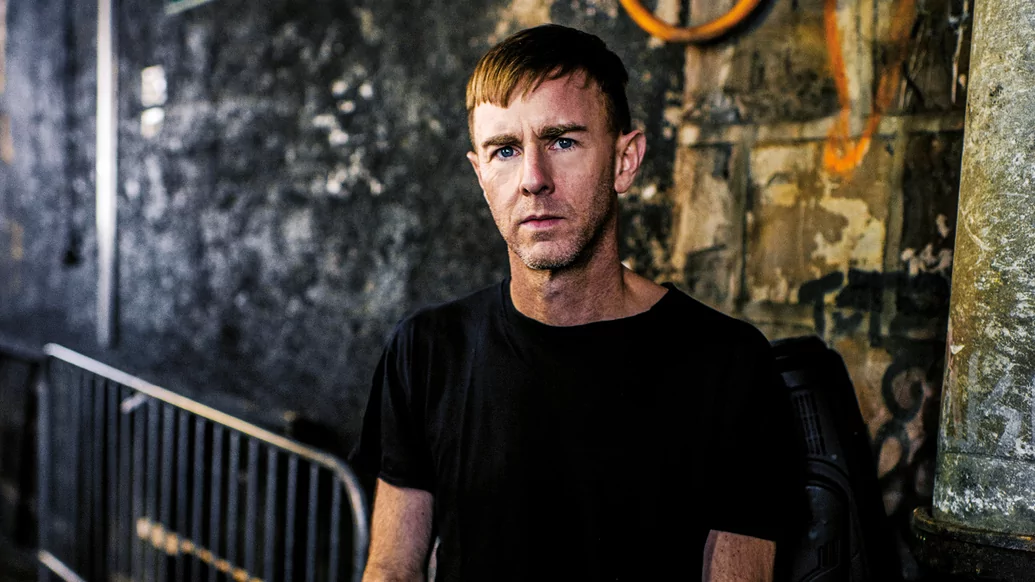

Technology
Hawtin’s relationship with technology is at the core of everything he does; from early days of tinkering with mechanical parts, to assisting in the development of timecode technology that eventually became Native Instruments’ Traktor Scratch and changed DJing forever, his investments in new music tech startups and, of course, the development of his own DJ mixer, the PLAYdifferently MODEL 1. While many of us consider the technological advancements of the past 25 years to be liberating — offering us powerful access to information, media and communication and the touch of a button — for Hawtin it’s more considered than that.
As more and more DJs are adopting the ‘live’ ethos — be it with an FX box in the booth, a sequencer running custom loops or a full-blown live show — it’s not so much a transition to another form of DJing, rather a throwback to a time before technology homogenized the art. “The idea of DJing has become even more limited over time,” says Hawtin. “In the early days when I started, it was quite normal to see a DJ bringing an FX box or a reel-to-reel into the booth. As our culture has evolved, the definition of DJing has become tighter and more specific. The equipment in the DJ booth has now become — for a lot of people — CDJs and a mixer. I think people are searching for a way to find their own identity over just music alone.
“That’s another thing that’s changed — when music wasn’t so readily available and you had your white labels that no one else had, your identity was built up from a musical perspective, which is the foundation point of any set: music. But now that everyone has access to the same music, how do you add something into that mix to give yourself more individual creative freedom? I think that’s maybe why you see people jumping into adding more instrumentation or bridging that gap between DJing and ‘live.’”
Dark side
Another progression in electronic music culture is less of a technical one. The discussion around mental health and the challenges that DJs, artists and professionals face while navigating our industry is continuing to increase, and with it, the realization of how serious the problem is. As a touring DJ of 25 years, surely Richie Hawtin isn’t immune to the darker side of dance music?
“Oh man, I’ll tell you what, this scene is not easy. I’ve been through my crazy times of drinking too much, or partying too much, but to be honest, that’s the easy part,” he admits. “The constant touring, late nights, no sleep, isolation from friends and family, sitting in strange hotel rooms, having a not-so-good gig, it’s extreme highs and extreme lows. It’s honestly not something everybody can do. I don’t know if I was born to do this job, or if I re-engineered myself over the past 25 years. It’s difficult, and it’s even more difficult now with the size of the scene, social media, the personalities. It’s incredibly challenging.”
What are the things that he’s found can combat the darker times? “Sleep a couple of months a year, get away from the scene, away from some of the technology, closer to friends and family, the warmth of familiar surroundings — you need to find this balance. As soon as you have some sort of success, whether it’s a label or a hot record, you’re going to have hundreds, if not thousands of friends. Millions of followers. But it’s not real. You’ll meet some real people through that but you’ve got to find a way to realize who’s real and who’s not and remember to try and keep those people who you knew before, in the early days, close to you.”
It’s interesting to hear a giant of the scene talk about “bad gigs.” There’s an assumption among the humble public that every show, every festival, every afterparty and every tour is jam-packed full of incredible, euphoric moments, especially for a veteran like Hawtin who’s played tens of thousands of gigs around the world. It’s certainly refreshing to hear that not every show goes to plan.
“The idea of a bad gig cuts even harder now because it’s the one thing that hardly anyone speaks about,” explains Hawtin. “Every gig now is really boiled down to the one-minute video post on Instagram, and every gig can look good. So, when you have a bad gig, and it appears that everything is going so good for everybody else, I think that can be really demotivating and pull you down really quickly. The best thing to do is go and listen to the music, find the tracks that make you smile and excited and play those records the next night. Or get a good night’s sleep, take a trip home, turn the music off, go and hang out with your girlfriend, your boyfriend, your mum and dad, have a meal, talk about something different and come back to it a few days later.”
The negative aspect of social media’s influence on all of society is not a new topic, but the more nuanced effects — like perceiving others as relentlessly successful during a dark or down period in your life or career — are a constant battle for many artists and producers in electronic music. Hawtin too, has had his darker moments. “You’re never gonna be in sync with everybody all the time and that’s been really hard across my career. I’ve had the super-high points thinking ‘Fuck, we’re on top of the world right now,’ label-wise, production-wise; then there’s been moments like [in] the late ’90s, when I was going through my minimal phase and I had people booing me because they just wanted ’97, ’98 super-hard techno. All I could do was play the music that made me happy, and just get through that.”
Reflective
As our conversation wraps, the journey we’ve been on over the past 60-something minutes has set Hawtin at ease. He’s sat back on the seat, content with the story he’s just told. It’s not often he looks back — nostalgia is the enemy of techno, after all — but in the brief moments he allows himself to contemplate his achievements, doubts, struggles and successes, it appears gently therapeutic for the Canadian techno legend. He’s talking calmly now, thinking out loud, reiterating his philosophies.
“Very early on, before it all started, John Acquaviva and I were heavily inspired by Mute Records, people like Depeche Mode and Nitzer Ebb, and our interpretation was that these people and labels were on a mission. This wasn’t something that was for a week or for a year, this is what they do.
“When we started to get some popularity, people came, bigger labels wanted to buy us out, they wanted to license things, make us stars. I don’t think we made every right decision, but for the most part, we always came back and said, ‘We wanna be here in five years, in 10 years, how do we keep doing this? How do we keep control? How do we enjoy this and how do we make this our life?’
“So, one bad gig, one bad decision, yes it fucking hurts for that moment, or for a couple of months; just come back to why you’re into this, come back to the music you love, the people you love, and go forward.”

